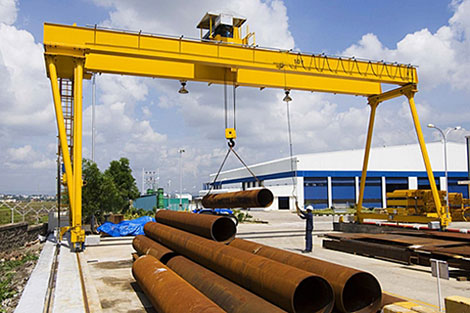Preparation and precautions before using gantry crane

The lifting mechanism, trolley running mechanism, and bridge structure of gantry cranes are basically the same as those of bridge cranes. Due to the large span, most crane operating mechanisms are driven separately to prevent the crane from tilting and increasing resistance, and even accidents.
Preparation work for gantry crane construction:
Longmen crane is a type of bridge type crane with a horizontal bridge frame set on two supporting legs to form a gantry shape. This type of crane operates on ground tracks and is mainly used for handling and installation operations in open-air storage yards, shipyards, power stations, ports, and railway freight stations. What work needs to be done before installation to improve the installation time of gantry cranes?
1. Check the integrity of the accessories and electrical system, and prepare the necessary sleepers;
2. Lay a solid foundation, level and compact the foundation, and ensure that the relevant specifications meet the acceptance standards of the construction unit;
3. Inspect the track foundation beam and measure its straightness, levelness, etc;
4. Carry out document inspection for construction personnel;
5. Advance preparation of relevant tools, installation technical documents, personal safety assurance, etc;
6. Issuing a written notice of commencement of work;
7. Check the integrity of the equipment;
8. Carry out the installation and layout of construction power supply and lighting equipment.
Operation method of gantry crane:
1. When lifting heavy objects, the wire rope of the hook should be kept vertical and not diagonally dragged.
2. The suspended heavy object should be accurately centered and securely tied. Use wooden pads for sharp edged applications.
3. Before lifting heavy objects off the ground, the crane shall not make any turning movements.
4. When lifting or lowering heavy objects, the speed should be uniform and steady to avoid sudden changes in speed that may cause the object to sway in the air and pose a danger. When dropping heavy objects, the speed should not be too fast to avoid damaging them when landing.
5. When lifting heavy objects, try to avoid lifting the boom as much as possible. When lifting and lowering the boom under lifting conditions, the lifting weight must not exceed 50% of the specified weight.
6. When the crane rotates under lifting conditions, close attention should be paid to whether there are obstacles around it. If there are obstacles, efforts should be made to avoid or remove them.
7. No personnel are allowed to stay under the crane arm, and efforts should be made to avoid personnel passing through.
8. Two cranes are operating on the same track, and the distance between them should be greater than 3m.
9. When two cranes are used to lift an object together, the lifting capacity shall not exceed 75% of the total lifting capacity of the two cranes, and the walking and lifting actions of the two cranes shall be consistent.
10. The lifting and variable amplitude steel wire ropes need to be inspected once a week and recorded. Specific requirements shall be implemented in accordance with the relevant regulations for lifting steel wire ropes.
11. When the empty vehicle is running or turning, the hook should be at least 2 meters above the ground.
12. When the wind exceeds level six, work should be stopped immediately. TMK should turn the arm to the downwind direction and lower it appropriately to securely hang the hook. The gantry crane must be equipped with iron wedges (rail stoppers) and the hook must be raised to the upper limit. At the same time, close the doors and windows, cut off the power, and pull the cable wind rope. After completing work, it should also be handled accordingly.
13. It is strictly prohibited to stack miscellaneous objects on the crane platform to prevent them from falling and injuring people during operation. Commonly used tools should be placed in a dedicated toolbox in the operating room.
14. During operation, sudden gear changes or reversing are not allowed to prevent heavy objects from swinging in the air, and it is also not allowed to simultaneously activate two or more operating mechanisms (including auxiliary hooks).
15. When driving, the operator's hands must not leave the controller. In the event of a sudden malfunction during operation, measures should be taken to safely lower the heavy object, then cut off the power and carry out repairs. It is strictly prohibited to conduct maintenance during operation.
Precautions for gantry crane:
1. Heavy objects exceed the rated lifting capacity of the crane.
2. The weight of the heavy object is unknown.
3. The signal is unclear.
4. The heavy object is not securely tied.
5. Outdoor operations encounter severe weather conditions such as strong winds of level six or above (level five on the beam), heavy rain, and heavy fog.
6. Poor lighting for night work.
7. Diagonal pull.
8. The steel wire rope is severely worn and has broken strands, and someone is conducting maintenance on the crane or machine room.




